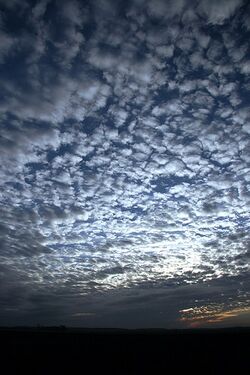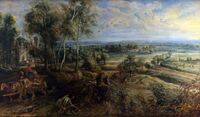Earth:Mackerel sky
| Mackerel sky | |
|---|---|
 Altocumulus mackerel sky | |
| Abbreviation | Ac |
| Symbol | |
| Genus | Alto- (mediumhigh) -cumulus (heaped) |
| Appearance | Clumps and rolls of clouds that resemble mackerel scales |
| Precipitation cloud? | No, but may signify approaching precipitation. |
A mackerel sky is a term for clouds made up of rows of cirrocumulus or altocumulus clouds displaying an undulating, rippling pattern similar in appearance to fish scales;[1][2] this is caused by high altitude atmospheric waves.[3]
Cirrocumulus appears almost exclusively with cirrus some way ahead of a warm front and is a reliable forecaster that the weather is about to change.[4] When these high clouds progressively invade the sky and the barometric pressure begins to fall, precipitation associated with the disturbance is likely about 6 to 12 hours away. A thickening and lowering of cirrocumulus into middle-étage altostratus or altocumulus is a good sign that the warm front or low front has moved closer and it may start raining within less than six hours.[5] The old rhymes "Mackerel sky, not twenty-four hours dry"[3] and "Mares' tails and mackerel scales make lofty ships to carry low sails"[6] both refer to this long-recognized phenomenon.
Other phrases in weather lore take mackerel skies as a sign of changeable weather. Examples include "Mackerel sky, mackerel sky. Never long wet and never long dry", and "A dappled sky, like a painted woman, soon changes its face".[4]
It is sometimes known as a buttermilk sky, particularly when in the early cirrocumulus stage, in reference to the clouds' "curdled" appearance.[7]
In culture
Peter Paul Rubens' A View of Het Steen in the Early Morning (c.1636) features a depiction of a mackerel sky in art.
"Ole Buttermilk Sky" by Hoagy Carmichael was nominated for an Academy Award for Best Original Song in 1946.
Gallery
References
- ↑ Downing, L. L. (2013). Metereology of Clouds. p. 154. ISBN 9781491804339. https://books.google.com/books?id=iazUAAAAQBAJ&pg=PT154.
- ↑ Ahrens, C. Donald; Henson, Robert (2015). Metereology Today. Cengage Learning. p. 153. ISBN 9781305480629. https://books.google.com/books?id=5Dx-BAAAQBAJ&pg=PT153.
- ↑ Jump up to: 3.0 3.1 Wong, Chi-wai. "Mackerel sky, not twenty-four hours dry". Hong Kong Observatory. http://www.hko.gov.hk/education/edu01met/wxobs/folklore/ele_mackerel_e.htm.
- ↑ Jump up to: 4.0 4.1 "Ontario Regional Marine Guide". Environment Canada. Archived from the original on 2015-12-03. https://web.archive.org/web/20151203133407/https://www.ec.gc.ca/meteo-weather/default.asp?lang=En&n=928EE83A-1.
- ↑ "Mackerel sky". Weather Online. http://www.weatheronline.co.uk/reports/wxfacts/Sometimes-a-bit-fishy.htm. Retrieved 21 November 2013.
- ↑ Lefevre, Karla (11 October 2013). "Making heads of mares' tails". NASA Earth Data. https://earthdata.nasa.gov/user-resources/sensing-our-planet/making-heads-of-mares-tails.
- ↑ Klocek, Dennis (2010). Climate: Soul of the Earth. SteinerBooks. p. 32. ISBN 9781584204589. https://books.google.com/books?id=n1s79da7DNUC&pg=PT32.
External links
 |






